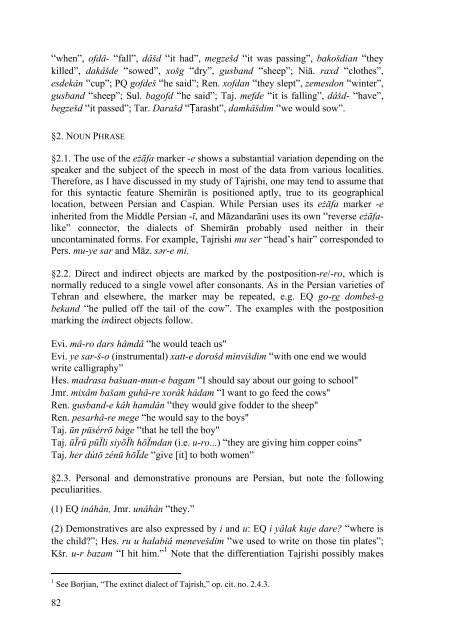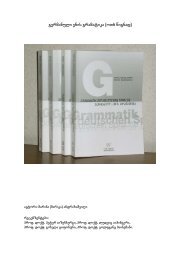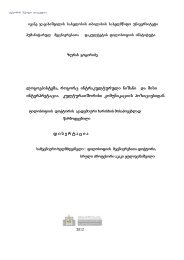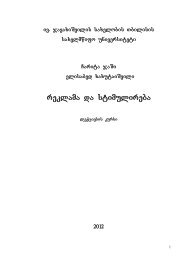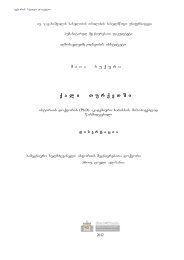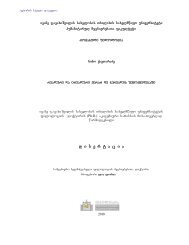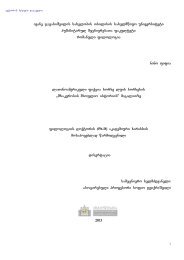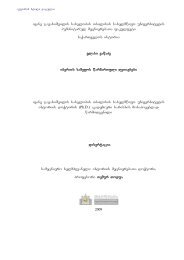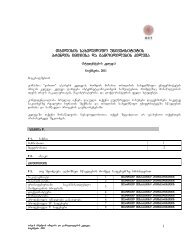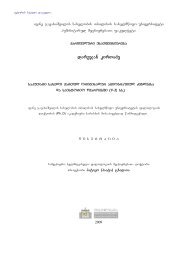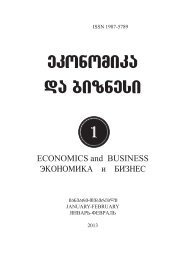issues of linguistics - Tbilisi State University
issues of linguistics - Tbilisi State University
issues of linguistics - Tbilisi State University
You also want an ePaper? Increase the reach of your titles
YUMPU automatically turns print PDFs into web optimized ePapers that Google loves.
“when”, <strong>of</strong>dâ- “fall”, dâšd “it had”, megzešd “it was passing”, bakošdian “they<br />
killed”, dakâšde “sowed”, xošg “dry”, gusband “sheep”; Niā. raxd “clothes”,<br />
esdekân “cup”; PQ g<strong>of</strong>deš “he said”; Ren. x<strong>of</strong>dan “they slept”, zemesdon “winter”,<br />
gusband “sheep”; Sul. bag<strong>of</strong>d “he said”; Taj. mefde “it is falling”, dâšd- “have”,<br />
begzešd “it passed”; Tar. Darašd “Ṭarasht”, damkâšdim “we would sow”.<br />
§2. NOUN PHRASE<br />
§2.1. The use <strong>of</strong> the eżāfa marker -e shows a substantial variation depending on the<br />
speaker and the subject <strong>of</strong> the speech in most <strong>of</strong> the data from various localities.<br />
Therefore, as I have discussed in my study <strong>of</strong> Tajrishi, one may tend to assume that<br />
for this syntactic feature Shemirān is positioned aptly, true to its geographical<br />
location, between Persian and Caspian. While Persian uses its eżāfa marker -e<br />
inherited from the Middle Persian -ī, and Māzandarāni uses its own “reverse eżāfalike”<br />
connector, the dialects <strong>of</strong> Shemirān probably used neither in their<br />
uncontaminated forms. For example, Tajrishi mu ser “head’s hair” corresponded to<br />
Pers. mu-ye sar and Māz. sər-e mi.<br />
§2.2. Direct and indirect objects are marked by the postposition-re/-ro, which is<br />
normally reduced to a single vowel after consonants. As in the Persian varieties <strong>of</strong><br />
Tehran and elsewhere, the marker may be repeated, e.g. EQ go-re dombeš-o<br />
bekand “he pulled <strong>of</strong>f the tail <strong>of</strong> the cow”. The examples with the postposition<br />
marking the indirect objects follow.<br />
Evi. mâ-ro dars hâmdâ “he would teach us"<br />
Evi. ye sar-š-o (instrumental) xatt-e dorošd minvišdim “with one end we would<br />
write calligraphy”<br />
Hes. madrasa bašuan-mun-e bagam “I should say about our going to school"<br />
Jmr. mixâm bašam guhâ-re xorâk hâdam “I want to go feed the cows"<br />
Ren. gusband-e kâh hamdân “they would give fodder to the sheep"<br />
Ren. pesarhâ-re mege “he would say to the boys"<br />
Taj. ūn püsérrō báge “that he tell the boy"<br />
Taj. ūÏrū pūÏli siyōÏh hōÏmdan (i.e. u-ro...) “they are giving him copper coins"<br />
Taj. her dútō zénū hōÏde “give [it] to both women”<br />
§2.3. Personal and demonstrative pronouns are Persian, but note the following<br />
peculiarities.<br />
(1) EQ inâhân, Jmr. unâhân “they.”<br />
(2) Demonstratives are also expressed by i and u: EQ i yâlak kuje dare? “where is<br />
the child?”; Hes. ru u halabiâ menevešdim “we used to write on those tin plates”;<br />
Kšr. u-r bazam “I hit him.” 1 Note that the differentiation Tajrishi possibly makes<br />
1 See Borjian, “The extinct dialect <strong>of</strong> Tajrish,” op. cit. no. 2.4.3.<br />
82


